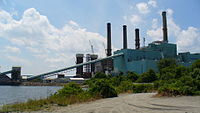
Photo from wikipedia
Abstract. Summer surface O3 pollution has rapidly intensified recently, damaging human and ecosystem health. In 2017, the summer mean maximum daily average 8 h concentration of ozone was greater than 150 μg/m3… Click to show full abstract
Abstract. Summer surface O3 pollution has rapidly intensified recently, damaging human and ecosystem health. In 2017, the summer mean maximum daily average 8 h concentration of ozone was greater than 150 μg/m3 in North China. Here, we show that in addition to anthropogenic emissions, the Eurasia teleconnection pattern (EUTP), a major globally significant atmospheric teleconnection pattern, influences surface O3 pollution in North China. The local meteorological conditions associated with the EUTP positive phase supported intense and efficient photochemical reactions to produce more surface O3. The associated southerlies over North China transported surrounding O3 precursors to superpose local emissions. Solar radiation and high temperature dramatically enhanced O3 photochemical reactions. Furthermore, due to the close connection between the preceding May Arctic sea ice and summer EUTP, approximately 60 % of the interannual variability of summer surface O3 pollution was attributed to Arctic sea ice to the north of Eurasia. This finding aids in the seasonal prediction of O3 pollution.
Journal Title: Atmospheric Chemistry and Physics
Year Published: 2018
Link to full text (if available)
Share on Social Media: Sign Up to like & get
recommendations!